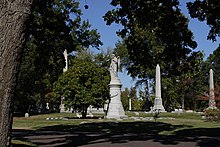John R. Anderson (minister)
Anderson worked as a typesetter for the Missouri Republican and for Elijah Parish Lovejoy's anti-slavery newspaper, the Alton Observer.
He founded the first African American Masonic temple west of the Mississippi River in the early 1860s.
[7][b] As a child, he learned to read at the Sunday school of the First Colored Church, which was established by Reverends James Welch and John Mason Peck.
[1][3] Anderson received most of his education in reading and theology at John Berry Meachum's "Freedom School,"[2] which was conducted on a riverboat in the Mississippi River.
[11] He was working when Lovejoy was killed in Alton, Illinois in 1837, and was an eyewitness to his murder and the destruction of the printing press.
[12] Unable to support himself and his family on the earnings from the church, Anderson worked in the City Jail as an assistant police officer for the rest of his life.
[17] Anderson was an anti-slavery activist who provided loans to purchase the freedom of enslaved people, preventing them from being sold into the Deep South to work on cotton plantations.
[6] The Central Baptist Church acquired two of its deacons after Anderson bought them from the slave pen in St. Louis.
[12] Harriet Robinson Scott, a member of the Central Baptist Church,[10] sought his advice for their freedom suit.
[20] After Meecham died in 1854,[e] Anderson ran the Freedom School for African American children.
With Galusha Anderson, a white Baptist minister, he lobbied the St. Louis school system for education for black children over a ten-year period.
[9] Anderson served on a board of education established to provide schooling for black students.
[17] This was accomplished during a period when the prevailing belief among pro-slavery and some anti-slavery factions that African Americans should not be educated.
[17] The St. Louis Board of Education petitioned the Legislature to enact laws to provide schools for African American children.




